VIII.4.2 Selection for heterozygotes, for example due to overdominance, can permanently maintain polymorphism in the population
Superdominanceand selection in favour of heterozygotes have already been discussed in Chapter IV.6.1.It followed from Equations (8) and (9) in Chapter IV.6.1 that an equilibrium frequency of the two alleles is established in dependence on the ratio of the selection coefficients of individuals with the particular genotypes.Polymorphism maintained by selection for heterozygotes is sometimes also termed balanced polymorphism.This mechanism is valid under conditions where the fitness of the heteozygote is greater than the fitness of any of the homozygotes.This case is apparently quite frequent (Fig. VIII.3)Geneticists sometimes connect this phenomenon with the heterosis effect, the
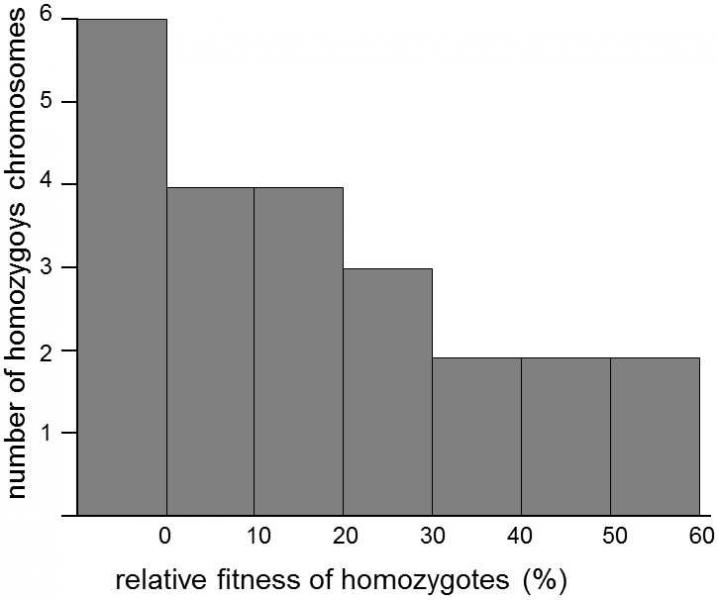
Fig. VIII.3. The effect of chromosome homozygosity on the biological fitness of drosophila. A line of drosophila was prepared in which all of chromosome No. 2 was converted to the homozygote state. Thus, each line bore two identical copies of some variants of this second largest chromosome, selected randomly in the natural population. The histogram depicts the separation effect of the homozygote chromosome on the relative biological fitness of members of the given line. It is apparent that partially homozygote flies attain a maximum of 60% of the fitness of the original line and that most of the variants of chromosome No. 2 occurring in nature are lethal or semilethal in the homozygote state. Data from Tracey and Ayala (1974), modified according to Dobzhansky et al. (1977).
greater viability of individuals with a high degree of heterozygosity (Hawkins & Day 1999).However, it is always necessary to strictly differentiate when the heterozygote actually has greater fitness and when it only has greater weight, e.g. as a consequence of poor balancing of ontogenetic processes.It is possible that a great many cases of the heterosis effect utilized in agriculture fall in this category.However, comparative studies simultaneously indicate highly significant correlation between the average heterozygosity in populations and the average fitness of their members (Reed & Frankham 2003).It is, however, apparent that, within a single population, individuals that are heterozygote in a large number of genes frequently actually do have greater fitness, exhibit mutually lower individual variability and their ontogenesis is more regular and more resistant against the action of external interfering effects (Fig. VIII.4).The latter fact is manifested, e.g., in lower fluctuation asymmetry in the body structures of species with bilateral symmetry, i.e. that component of morphological asymmetry that is manifested in some individuals in the population in a greater size of a certain structure on the right-hand side of the body and in some individuals on the left-hand side.
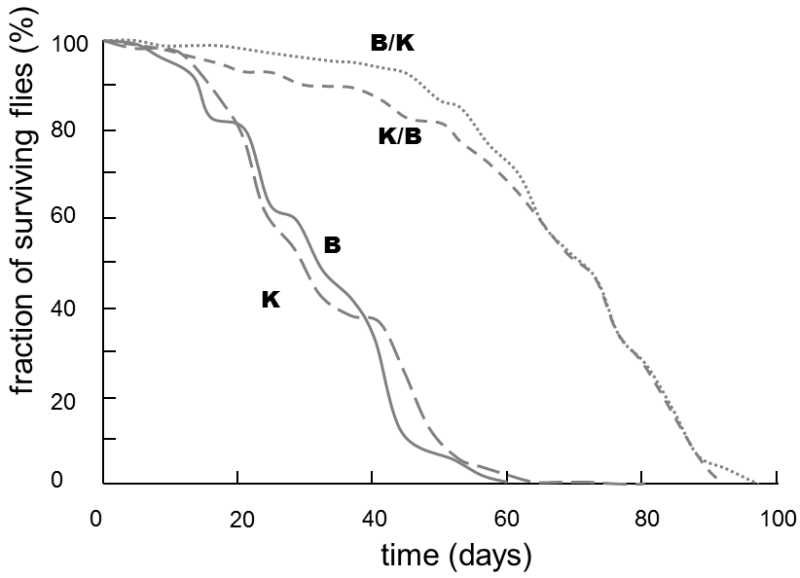
Fig. VIII.4. Heterosis effect. The graphs depict the progress of dying out of the populations of two pure lines of drosophila (B and K) and both populations of F1-crosses of these lines. It is apparent that the F1-crosses survive substantially longer than the members of the parent lines. Data according to Clarke and Maynard Smith (1955), modified according to Maynard Smith (1998).
The cause of the greater viability of heterozygotes is not currently completely clear.According to some theories, this lies in the relatively greater number of recessive harmful (negative) mutations in the homozygous state in the genotype of homozygous individuals.An individual that is a homozygote in a great many genes is apparently the progeny of two mutually related individuals so that an elevated probability of the occurrence of rare harmful mutations in the homozygous state can be expected (Fig. VIII.5).According to some authors, the importance of this mechanism is reflected, e.g., in the
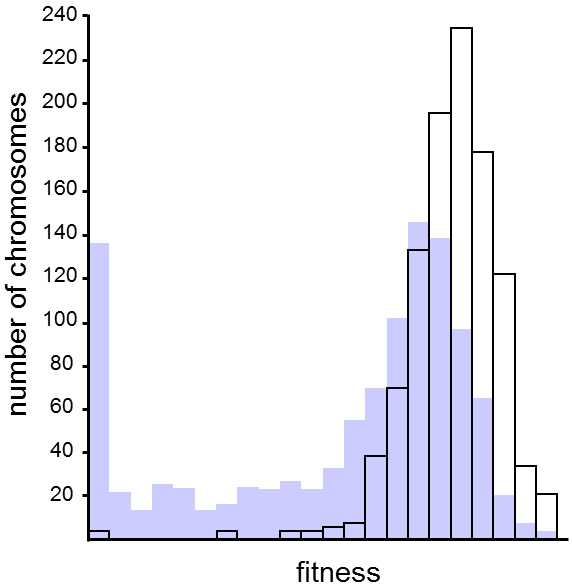
Fig. VIII.5. The presence of recessive lethal and semi-lethal mutations in the gene pool of drosophila. The histogram depicts more detailed results of the experiment described in the legend to Fig. VIII.3. In this case, the overall biological fitness of the bearers of a certain genotype was not plotted on the graph, but only their viability, and the graph also depicts data for heterozygotes bearing two variants of chromosome No. 2 (empty columns). The pattern of the distribution, specifically the low number of chromosomes with medium effect on the viability of the individual, indicates that a small number of recessive genes with lethal effect tend to have a major impact in the negative effect of homozygosity. Data from Dobzhansky and Spassky (1963), modified according to Dobzhansky et al. (1977).
fact that haplodiploid species, in which recessive lethal and highly harmful mutations are eliminated in haploid males, exhibit relatively lower polymorphism (Edwards & Hoy 1993).According to this model, the elevated viability of heterozygotes tends to be a manifestation of the reduced viability of homozygotes occurring through inbreeding, i.e. reproduction amongst relatives.If this were actually true, then the phenomenon of elevated viability of heterozygotes and the long-term survival of polymorphism in the population would not be functionally interconnected.A high degree of heterozygosity would only be an indication of a low level of inbreeding and thus low probability of the occurrence of rare harmful recessive mutations in the homozygous state in the given individual.
Another possible explanation of the greater fitness of heterozygotes is based on the assumption that the products of the individual alleles of a single gene fulfill a different function in the cell to at least some degree. A heterozygous individual with two different alleles of a given gene is thus necessarily at an advantage over any homozygous individual. For example, different alleles exist in the population for a large percentage of enzymes, differing in their isoelectric point and thus mobility in an electric field.The occurrence of these alleles forms the basis for alozyme analysis (see XXIV.3.6).It is quite possible that the cell both accelerates and regulates its physiological processes by forming a pH-gradient and simultaneously an electric field in its interior and thus both concentrates and, as required, relocates the molecules of the individual enzymes to various areas of its inner space through intracellular isoelectric focusing (see also XII.5) (Flegr 1990), (Flegr 2009).The presence of two forms of enzymes differing in their isoelectric points can substantially assist heterozygotes to increase the effectiveness of some cellular processes, as it facilitates the simultaneous presence of the same enzyme activity of a monomeric enzyme at two places and of a multimeric enzyme at several places in the inner space of the cell (Fig. VIII.6).
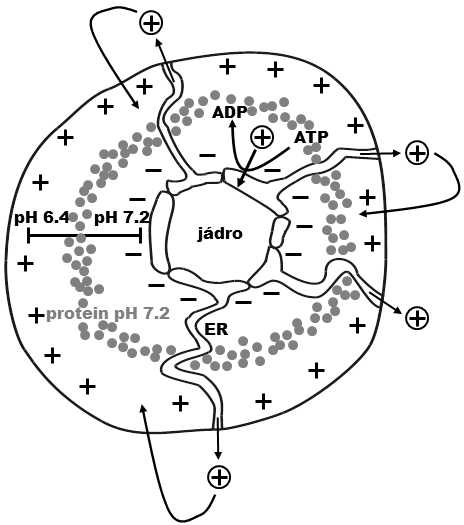
Fig. VIII.6. One of the possible mechanisms of intracellular isoelectric focusing. The cell can transport H+ ions through channels of endoplasmatic reticula (ER) from the central part of the cell to the surrounding medium, as a result of which they form both a pH gradient of 6.4 – 7.2 inside the cytoplasm (Slavik & Kotyk, 1984) and also an electromagnetic field. The individual proteins and individual low-molecular-weight substances can be concentrated in this gradient in dependence on their isoelectric points (isoelectric point = the pH value at which the particular molecule has zero charge or, to be more exact, at which it has zero mobility in an electromagnetic field) into concentric spherical layers. Concentration of the molecules of the enzymes of one metabolic pathway into a small space can substantially accelerate the consequent reaction rate. Through changes in the electric charges of the individual proteins, e.g. through their phosphorylation or dephosphorylation, the cell can relocate the individual enzymes and thus turn on and off the individual intracellular processes. Calculations demonstrate that, for example, a cell of the yeast S. cerevisiae could, with expenditure of a negligible part of its energy reserves, maintain an electric charge of 0.29 volts in its inner part, permitting very effective focusing of protein molecules (Flegr, 1990) Flegr, J. 1996 )
The correlation between the polymorphism in the population and the intensity of environmental stress to which the populations or species are exposed in their environment is an indirect proof for maintenance of polymorphism through selection for heterozygotes.Thus, populations occurring at places with extreme and very variable natural conditions, for example in warm areas on the side of a valley exposed to the sun (FIG. VIII.7) exhibit substantially greater polymorphism.On the other hand,
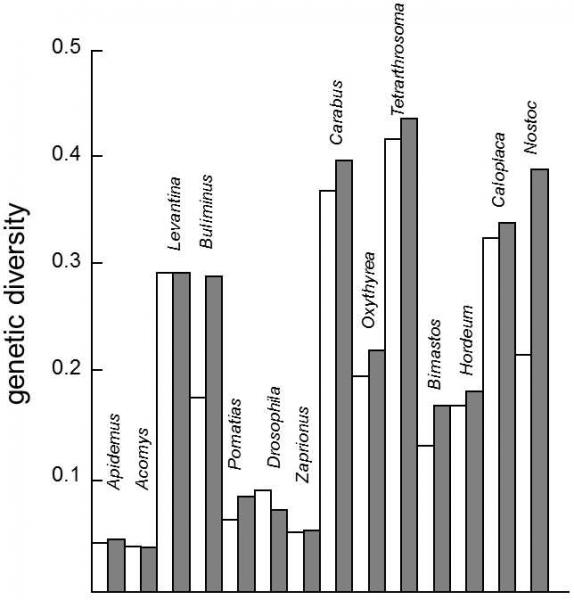
Fig. VIII.7. Ecological importance of polymorphism. The populations of animals and plants on the southern slopes of the Lower Nahal Oren canyon (full column) in the Mount Carmen range in Israel mostly have greater genetic polymorphism than the populations living on the northern slopes (empty column), where the climatic conditions are much milder and more stable. The algae Nostoc linckia were studied by the AFLP (Arbitrary Fragment Length Polymorphism) method, the other organisms, i.e. Caloplaca aurantia (lichen), Hordeum spontaneum (wild barley), Bimastos syriacum (earthworm), Buliminus labrosus, Pomatias olivieri and Levantina caesareana (snails), Drosophila simulans and Zaprionus tuberculatus (fruit flies), Tetrarthrosoma syriacum (centipede), Carabus hemprichi and Oxythyrea noemi (beetles), and Acomys cahirinus and Apodemus mystacinus (mice), were studied using allozyme analysis. The genetic polymorphism is expressed by the index of heterozygosity (see IX.5). Modified according to Nevo (2001).
species occurring in an unvarying, stable environment, such as underground species, exhibit low polymorphism (Nevo, Filippucci, & Beiles 1994; Nevo 2001).This general trend indicates that polymorphism apparently has functional importance and increases the resistance of the population and evidently also of individuals against the action of various stress factors occurring in the environment.
The main objection to the importance of selection for heterozygotes for maintenance of the more important part of polymorphism in the natural population is that, in this case, the fitness of inbred individuals would have to be unrealistically low compared with outbred individuals.The selection coefficients of the individual alleles in the homozygous state would have to have a certain minimal value for any of the polymorphic genes in order to maintain the relevant content of the two alleles in the population.However, for inbred individuals, all the genes would have to be in the homozygous state, so that the overall fitness of these individuals would basically have to equal zero.
The relatively high polymorphism of a number of haploid species, including bacterial species, provides further evidence for the lower importance of selection for heterozygotes(Kimura 1985).This mechanism can, of course, not be operative for haploid species.
